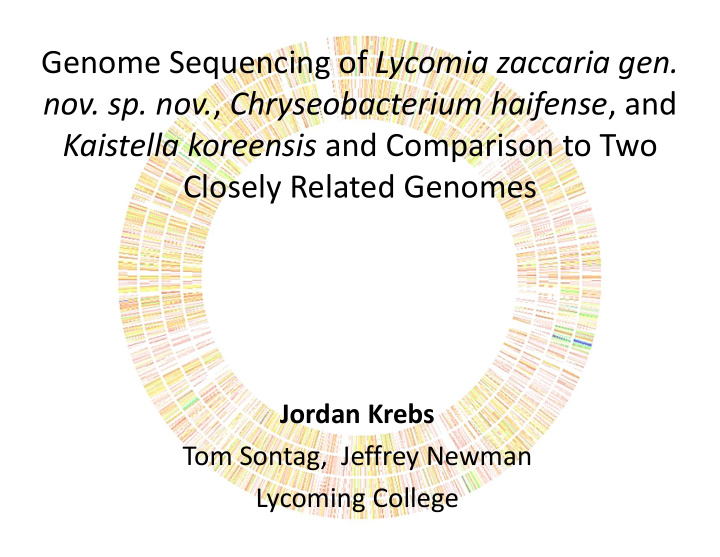



Genome Sequencing of Lycomia zaccaria gen. nov. sp. nov. , Chryseobacterium haifense , and Kaistella koreensis and Comparison to Two Closely Related Genomes Jordan Krebs Tom Sontag, Jeffrey Newman Lycoming College
Species Introduction Chryseobacterium shigense Chryseobacterium vrystaatense Chryseobacterium luteum Chryseobacterium sp. KM Chryseobacterium joostei Chryseobacterium jejuense Chryseobacterium oranimense Chryseobacterium gleum Chryseobacterium soli Chryseobacterium soldanellicola Chryseobacterium sp. CTM Chryseobacterium sp. VR86 Chryseobacterium greenlandense 3519 Kaistella koreensis Chryseobacterium haifense Lycomia zaccaria JJC 3519 0.005 Phylogenetic and molecular evolutionary analyses were conducted using MEGA version 5 (Tamura, Peterson, Stecher, Nei, and Kumar 2011).
Methods Assemble Download Reference Genomes Sequence Genomes Upload into RAST Find and Annotate Genes L. K. C. C. gleum 3519 zaccaria koreensis haifense JJC Function ‐ Based Analysis Sequence ‐ Based Analysis
RAST Subsystems Amino Acids and Fatty Acids, Lipids, and RAST ‐ Rapid Annotation Derivatives Isoprenoids Carbohydrates Membrane Transport based on Subsystem Technology Protein Metabolism of Metabolism Aromatic Compounds DNA Cell Division and Cell L. zaccaria JJC Metabolism Cycle RNA metabolism Nitrogen Metabolism Cell Wall and Phosphorus Capsule Metabolism Cofactors, Vitamins, Regulation and Cell Prosthetic Signaling Groups, Pigments Virulence, Disease, and Potassium Metabolism Defense Nucleosides and Sulfur Metabolism Nucelotides Dormancy and Stress Response Sporulation Iron Acquistion and Miscellaneous Metabolism Secondary Metabolism Respiration Phages, Prophages, Transposable elements, Plasmids
RAST
C. gleum Sequence Based 5.6 Mbp Analysis L. zaccaria JJC 3.2 Mbp 81 43 64 89 81 20 K. koreensis 3.8 Mbp 40 73 118 74 25 9 86 140 12 20 3519 115 C. haifense 2.8 Mbp 3.5 Mbp Figure inspired by Figure of http://xsplat.wordpress.com
Subsystems K. koreensis C. gleum Amino Acids and Derivatives Carbohydrates Protein Molybdenum cofactors Metabolism biosynthesis DNA Metabolism Trehalose permease RNA metabolism Alanine racemase Cell Wall and (FucP) Capsule Phage tail fiber protein Trehalase Cofactors, Retron ‐ type RNA ‐ Vitamins, Sulfite reductase directed DNA Prosthetic Siderophore synthesis Groups, Pigments polymerase L. zaccaria JJC Flexirubin synthesis Virulence, Disease, and (darA) Defense Nucleosides and Nucelotides Beta ‐ lactamase/Penicillin Formate ‐ THF ligase Stress Response Thiol peroxi ‐ binding proteins P yruvate, phosphate ‐ Miscellaneous dase, Tpx ‐ type Cytosine deaminase dikinase Respiration Fatty Acids, Serine Butyryl ‐ CoA Beta ‐ lactamase Amino ‐ Lipids, and acetyl ‐ dehydro ‐ Gliding motility deoxych ‐ Isoprenoids trans ‐ genase Ornithine , Xaa ‐ Pro orismate ferase Membrane Aminopeptidases lyase Transport DEAD ‐ box protein A Metabolism of Mn superoxide dismutase Bacterophytochrome heme Fumarate Aromatic GroEL, GroES, GrpE hydratase oxygenase BphO Catalase Compounds Cell Division and Catechol 1,2 ‐ dioxygenase Sucrose ‐ 6 ‐ phosphate Cystathionine methyleneTHF Cell Cycle syn. & lyase reductase D ‐ beta ‐ hydroxybutyrate hydrolase Nitrogen dehydrogenase Alpha ‐ acetolactate Metabolism Arginino ‐ Phosphorus succinate Methylglyoxal synthase decarboxylase Metabolism Syn. Regulation and Cell Signaling Potassium Metabolism Sulfur Metabolism Dormancy and Integron integrase Sporulation Minor curlin subunit CsgB Iron Acquistion and Metabolism (nucleation) Secondary 3519 Serine phospatase RsbU – Metabolism regulator of Phages, C. haifense Prophages, sigma subunit Transposable elements, Adapted from Zhaxybayeva O et al. PNAS 2009;106:5865 ‐ 5870 Plasmids
References 1. Aziz, R.K., Bartels, D., Best, A.A., DeJongh, M., Disz, T., Edwards, R.A., Formsma, K., Gerdes, S., Glass, E.M., Kubal, M., Meyer, F., Olsen, G.J., Olson, R., Osterman, A.L., Overbeek, R.A., McNeil, L.K., Paarmann, D., Paczian, T., Parrello, B., Pusch, G.D., Reich, C., Stevens, R., Vassieva, O., Vonstein, V., Wilke, A., & Zagnitko O. (2008). The RAST Server: Rapid Annotations using Subsystems Technology. BMC Genomics 9:75 2. Hantsis ‐ Zacharov, E. & Halpern, M. (2007). Chryseobacterium haifense sp. nov., a psychrotolerant bacterium isolated from raw milk . Int J Syst Evol Microbiol 57, 2344–2348. 3. Holmes, B., Owen, R. J., Steigerwalt, A. G. & Brenner, D. J. (1984). Flavobacterium gleum, a new species found in human clinical specimens . Int J Syst Bacteriol 34, 21–25. 4. Kampfer, P., Vaneechoutte, M., Lodders, N., De Baere, T., Avesani, V., Janssens, M., Busse, H. ‐ J. & Wauters, G. (2009). Description of Chryseobacterium anthropi sp. nov. to accommodate clinical isolates biochemically similar to Kaistella koreensis and Chryseobacterium haifense, proposal to reclassify Kaistella koreensis as Chryseobacterium koreense comb. nov. and emended description of the genus Chryseobacterium . Int J Syst Evol Microbiol 59, 2421–2428. 5. Tamura, K., Peterson, D., Peterson, N., Stecher, G., Nei, M., and Kumar, S. (2011). MEGA5: Molecular Evolutionary Genetics Analysis using Maximum Likelihood, Evolutionary Distance, and Maximum Parsimony Methods . Molecular Biology and Evolution (submitted). 6. Vandamme, P., Bernardet, J. ‐ F., Segers, P., Kersters, K. & Holmes, B. (1994 ). New perspectives in the classification of the flavobacteria: description of Chryseobacterium gen. nov., Bergeyella gen. nov., and Empedobacter nom. rev . Int J Syst Bacteriol 44, 827–831. 7. Zhaxybayeva, O., Swithers, K.S., Lapierre, P., Fournier, G.P., Bickhart, D.M., DeBoy, R.T., Nelson, K.E., Nesbø, C.L., Doolittle, W.F., Gogarten, J.P., and Noll, K.M. (2009). On the chimeric nature, thermophilic origin, and phylogenetic placement of the Thermotogales. Proc. Natl. Acad. Sci. U.S.A. 106: 5865 ‐ 5870.
Acknowledgements From left to right: Back: Dr. Newman, Andrew Gale (‘15), Dillon Snyder (‘14), Tom Sontag (‘14), Logan Mariano (‘13), Me, Clark Thompson (‘13) Front: Jessica Hoffman (‘15), and Jessica Lehman (‘13)
Recommend
More recommend